Articles
Nineteenth-Century Canadian Children's Games
Jusqu' au XIXe siècle, les activités et les objets traditionnels étaient à l'origine de la plupart des jeux et du matériel de jeux à la disposition des enfants d'Occident. Ces jeux séculaires ont traversé les âges jusqu'au XXe siècle grâce aux enfants qui se sont relayés pour en transmettre la connaissance. On retrouve, sous une forme ou sous une autre, ces jeux traditionnels dans le répertoire des activités ludiques des enfants d'aujourd'hui. Pendant le XIXe siècle, une gamme sans précédent de jeux et de matériel de jeux conçus expressément pour les enfants a été fabriquée industriellement. Produits en Europe et aux Etats-Unis, ces articles ont été importés au Canada en nombre toujours croissant tout au long du siècle. L'ampleur des modifications qu'ils ont fait subir aux jeux traditionnels reste à préciser, tout comme l'influence qu'ils ont exercée sur la période de loisir des enfants et leur conception du monde.
In the Western world, up until the nineteenth century, the range of children's games and game materials were largely made up of traditional activities and objects. Many of these games had been played for centuries and knowledge of them was passed from one child to another, right into the twentieth century. Forms of most of these traditional games can be found within the repertoire of children's play activities today. During the 1800s, an unprecedented array of games and game materials designed specifically for children were manufactured commercially. These items were produced in Europe and the United States and imported into Canada in increasing numbers over the century. To what degree they altered the play of traditional games remains to be determined, as does the effect they had on the child's leisure time and world view.
1 In the Western world, up until the nineteenth century, the range of children's games and game materials were largely made up of traditional activities and objects. Many of these games had been played for centuries and knowledge of them was passed from one child to another, right into the twentieth century. Forms of most of these traditional games can be found within the repertoire of children's play activities today. During the 1800s, an unprecedented array of games and game materials designed specifically for children were manufactured commercially. These items were produced in Europe and the United States and imported into Canada in increasing numbers over the century. To what degree they altered the play of traditional games remains to be determined, as does the effect they had on the child's leisure time and world view.
Games Defined
2 A game is usually defined as a contest, in which all players initially have the same capability to win.1 Games end when play determines a winner or loser. Game play may appear spontaneous and unsupervised, but is in fact guided by rigid rules. We say "play by the rules or you're out" and use symbols like "times out" to temporarily release us from the rules of play. Sociologists view games as "structured systems of behaviour," separate from the "real world."2 Games can be played without objects, although we often associate the term game with a visible item. Games differ from pastimes and toys because these activities do not contain the element of competition nor organized rules of play. Some items that are used in pastime play, such as tops or kites, can become game items when play turns competitive, such as in duelling tops or kite contests. Games can be played by one player alone, as in card games such as solitaire, where the opposition lies in the difficulty built into the rules of the game, or puzzles, where the real opponent is the design of the game device.3
3 Game behaviour is culturally based and tends to be conservative, that is, it changes much slower than the rate of change of game objects. Design of game items, especially design elements necessary for proper functioning of the game (as in the cubic shape of a die) also change slower than the substance of these materials, which may not be critical, and is influenced by technological innovation. For instance, chess is an ancient East Indian war game that was adopted by the Persians and subsequently diffused through Europe at the time of the Crusades. The European form of chess has not changed substantially in the last eight hundred years, nor has the design of the chess board or playing pieces. The manufacture of these game materials certainly has, and we can now play chess on a computer. Nevertheless, we are still playing the same eight hundred-year-old game, following the same rules, and using a simulation of a very traditional playing surface with traditional playing pieces.
Research on Children's Games
4 Games and game playing are the subject of study of several disciplines, but most research on traditional children's games has been conducted by folklorists. This is due largely to the oral nature of children's game play and the method of game transmission, which is usually demonstratively from child to child, with rules fixed only by custom and tradition.4 Hide and seek is an example of this type of game. Nineteenth-century folklorists such as Gomme (Traditional Games of England, Scotland and Ireland)5 and Newell (Games and Songs of American Children)6 focussed not only on the words, tune, materials and method of play of children's games, but also on their symbolic roots. Games like London Bridge is Falling Down were thought to reflect ancient beliefs about spirits of a river sabotaging manmade objects (bridges) designed to control them.7 These extrapolations were sometimes highly speculative and have become traditional beliefs on their own. Today, researchers are more concerned with game forms and variations, game preferences and cultural attitudes toward game play.
5 Little study of children's games and game play in Canada during the nineteenth century has been conducted. Canada did not have folklore scholars during this period like Newell (United States) and Gomme (Britain) conducting systematic collecting and analysis of traditional children's games. Primary and secondary sources that mention or describe games are generally limited to children's literature published during the 1800s outside Canada. Occasionally, items like children's diaries containing entries about game play or paintings and photographs of children playing games surface; these are scarce but invaluable records.
6 Comparative analysis of game materials from the 1800s is difficult because both traditional and popular commercial game objects from the nineteenth century are poorly represented in museum and private collections. This is attributable in part to the ephemeral nature of some game items, such as homemade tops. Like toys, favourite game materials were often played with until they fell apart. Unlike toys, sentimental care rarely extended to preserving game materials in the home. Game objects have been largely undervalued as cultural objects by history museums partly because they lack the artifact qualities traditionally cherished: they are rarely valuable in a monetary sense, have little of the sentimental value attached to dolls and other toys, and are often visually modest. In addition, our own cultural traditions and beliefs about pioneer life in Canada as a hard working, puritanical period have swayed our understanding and collecting of games and leisure materials. Recent interest by history museums in games and pastimes has been fostered not so much by a perceived need to understand games and their place in Canadian culture, but by a need to produce a variety of dynamic programmes for school groups, including playing traditional games. Current collecting of nineteenth-century handmade games and game boards has been precipitated by the folk art movement, which focuses on the design and form of these boards as aesthetic objects. Little attention is paid to the function of the board as a game. Because research materials are limited, children's games and game materials in Canada during the nineteenth century can only be discussed in general terms.
Traditional Children's Games
7 Traditional, or "folk,"8 games played in Canada during the nineteenth century encompass games without objects, including rhyming and chasing games, and games with objects, such as hoop rolling. Many of these games were culturally widespread and their long and poorly documented use makes it difficult to determine a place or time of origin for them. As with other aspects of folk culture, basic play of these games has tended to remain stable over time with some development of regional variations.9 Although there is little documentation of nineteenth-century Canadian children playing these games, we can deduce that their contemporary presence in our school yards and playgrounds is a function of cultural tradition, based on British, American and European antecedents that have been illustrated and described (see figs. 1 and 2). Outdoor activities during the nineteenth century included many of the games children still play today, such as tag, skipping, hopscotch, hide and seek, leap frog, crack the whip, etc. Church picnics and civic celebrations advertised a number of organized events for children, including race competitions such as sack races and wheelbarrow races.
8 Singing games show a strong adherence to structure and cadence with variation in verse. Edith Fowke's collection of Canadian children's singing games made during the 1960s show antecedents in both Newell and Gomme. Counting out rhymes like:
Fillisy, Follisy, Nicholas, John
Beaver, weaver, stingelum, steever,
O-U-T-spells, "out"10
which was reportedly used in Peterborough in 1875, show up in Fowke's collection as
Fillicy, fallacy my son John
Quebum quavum English knavum
Stringle-um, strangle-um, BUCK!11
Her source dated its use to 1900 in Tintern, Ontario. Newell includes the following version used in New England about 1820:
Filisy, folasy, Nicholas John
Queevy, quavy, Irish Mary
Stingalum, stangalum, buck.12
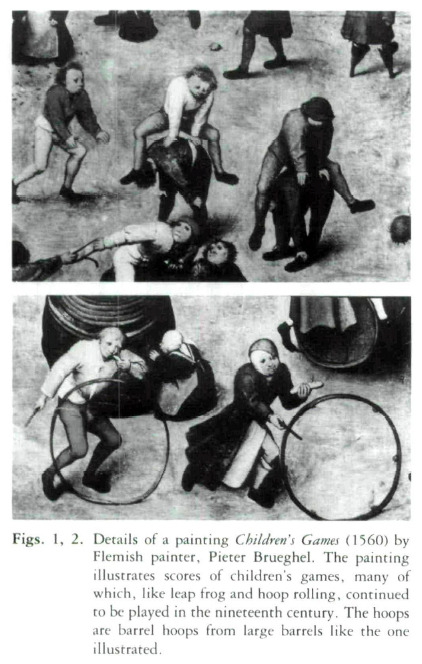 Display large image of Figure 1
Display large image of Figure 19 Other singing games, such as London Bridge, I Sent A Letter to My Love, A Tisket A Tasket, In and Out the Windows, etc., which many of us know from our own youth, are recorded in both Newell and Gomme. Forms of these games and skipping rhymes were probably part of the répertoire ot many nineteenth-century English-speaking Canadian children. Observation of recent changes in these types of rhymes may provide us with insight into how these changed and developed with modification of words contrasting with permanence of structure and nine. A skipping rhyme that I knew as a child had a very old cadence but a contemporary popular theme: "Hopalong Cassidy How About a Date?" Today children sing "Hey Fonzy!, How About A Date?"13 Many of the words of the original have been maintained, and the skipping game is still the same. The best sources on singing, rhyming and outdoor games in the nineteenth century are Fowke, Gomme, Newell and Brewster.14
10 Traditional children's games often use found, handmade, or locally made objects in the play, although a handmade game item does not necessarily mean that it is traditional. The corollary of this is also true: commercially, mass-produced game items may be traditional in form and use.15 These game materials include tops, and during the nineteenth century tops were sometimes handmade by children using an old spool and a sharp dowel. A boy's diary dated 1866 from Wellington County in Ontario notes the purchase of two tops from a store.16
11 Judging by the number of illustrations of children with hoops, hoop rolling appears to have been a popular activity. Hoops were made of metal or wood. Barrels were the source of free hoops, but were difficult to roll because one edge of the hoop had a greater circumference than the other. Blacksmiths produced fine metal hoops with accompanying rods called "girs." Hoops provided a companion to the child enroute, and were rolled to school, on shopping trips and in hoop races with other children. The demise of the hoop seems to correlate with the introduction of the bicycle.
12 The bilboque, also known as ring and pin, or cup and ball, is an old gaming device that was present in Canada during the nineteenth century although its distribution is unknown. This manipulative device requires the child to hold onto the handle, swing the attached ting or ball up, and catch it onto the point or in the cup of the handle.
13 Traditional puzzles seem to have been favourite game items throughout the nineteenth century. Children's books and journals often contained instructions for making puzzles, magic tricks and conjuring.
14 Traditional puzzle materials included topological puzzles, in which one tried to separate intertwined parts. Instructions for the handwrought metal reproduction puzzle (fig. 3) and the wooden heart puzzle (fig. 4) are found in Games and Diversions of Argyleshire, published in 1900.17 However, the reproduction is of an eighteenth-century piece in the collection of the Smithsonian Institution, while the heart puzzle is actually a contemporary piece made by a Waterloo County Old Order Mennonite craftsman in the traditional style he knows. Identical forms of these traditional puzzles were created in ivory by Chinese artisans in the mid-nineteenth century for a wealthy Western market. The knowledge of these puzzle forms seems to have been widespread, and they have been documented for centuries in the Orient and Europe. Shuttle puzzles, in which the numbered or lettered squares must be aligned chronologically within a frame, were also handmade out of wood for children. Plastic versions are popular today.
15 Other traditional game items would have included skipping ropes, strings for cat's cradle, stilts, kites, knuckle-bones and marbles.
16 Clay marbles were available early in the nineteenth century and were by far the cheapest marble type. Children often made their own, called "marrididdles" in Gomme's publication. Hand-blown glass marbles were exported from Germany by the 1840s, and although these were much more expensive than the clay versions, they show up in large quantities in collections. This is probably an indication of contemporary collecting preferences as much as use and distribution of glass marbles during the nineteenth century. The 1866 boy's diary from Wellington County mentioned previously has the entry "Washy Shepherd gave me 30 glass allies today." Glass marbles were handmade throughout the century and it was not until the 1900s that machine-made marbles were produced. Porcelain marbles were also available. These appear in lesser quantities in contemporary collections, due to either lower demand and production volumes, greater fragility, or lack of collecting interest. Although these latter objects were not necessarily handmade or locally made, they were used in traditional marble games, such as Ring-Taw and Nine-holes.
17 With the exception of biloque, most of these games are recognized by twentieth-century school-aged children who visit the Museum and Archive of Games, University of Waterloo, because the games formed part of the traditions carried by most eighteenth-, nineteenth-, and twentieth-century immigrants to Canada.
18 Traditional board games were carved and painted by hand throughout the 1800s and to a lesser degree into the 1900s. While these games were likely fashioned by adults and may have been intended for adult play, we know that children also played them.18 Handmade boards not only expressed individual craftsmanship, but often reflected cultural tradition in manufacture, design and play of the game. A special form of checkers was, and still is, played in Quebec. Jeu de dames uses a checkerboard of twelve by twelve squares rather than the standard chess/checker board of eight by eight squares. Other boards were designed for games of backgammon, Parcheesi, Fox and Geese, and Mill, also called Nine-Men's Morris. Fox and Geese is a game in which one player has one piece, the fox, which has great mobility to "capture" the many geese trying to surround and immobilize the fox. This game is played on the same board as solitaire (today known by the brand name High Q). Mill, or Nine Men's Morris, is an ancient game which had widespread play throughout the Middle East and Europe. The game board is a series of concentric squares joined by intersecting links, and the object of the game is for players to get as many three-in-a-row combinations as possible. Why these last two traditional games seem to have declined in popularity through the twentieth century may be explained in part by the lack of commercial adoption and promotion oi these games. Older visitors to the Museum and Archive of Games sometimes recognize these games, while younger visitors generally do not.
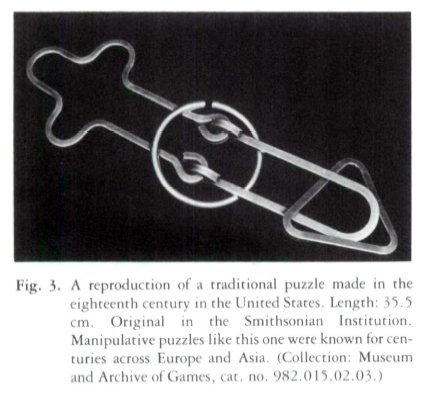 Display large image of Figure 2
Display large image of Figure 2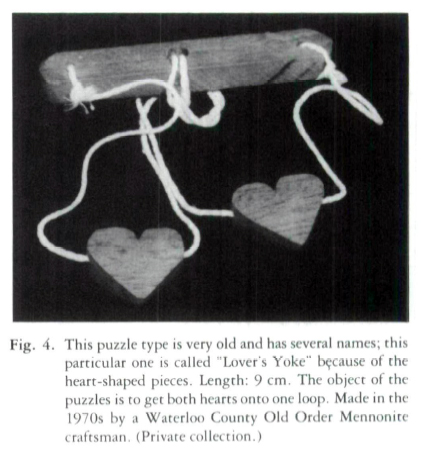 Display large image of Figure 3
Display large image of Figure 3Commercially Manufactured Games
19 The nineteenth century witnessed the rapid growth and development of an educated middle class, which for the first time provided a market for the establishment of a strong game industry. This industry not only produced copies of traditional and classic games, but developed new games and game materials for a growing children's market. These materials permeated an area of material culture previously dominated by locally made or handmade items designed for games traditional to the population they served.
20 Throughout the nineteenth century imported commercially manufactured games were available to those who could afford them. The influx of manufactured seems to have been well underway by the 1850s and continued progressively through the century to the present. Major sources of these goods were Britain, the United States, Germany and France. American mail-order catalogues were established by the 1870s and Eaton's produced its first catalogues in the 1880s. However, it was not until the latter part of the century that game companies began manufacturing in Canada. This delay was probably due to the lack of a strong, year-round market (games were mainly advertised and bought at Christmas) and the earlier development of established firms in Britain and the United States. The major changes in commercially produced games over the century were in game themes, game design and method of construction, the last two factors resulting in cheaper production, lowered unit prices and greater market penetration.
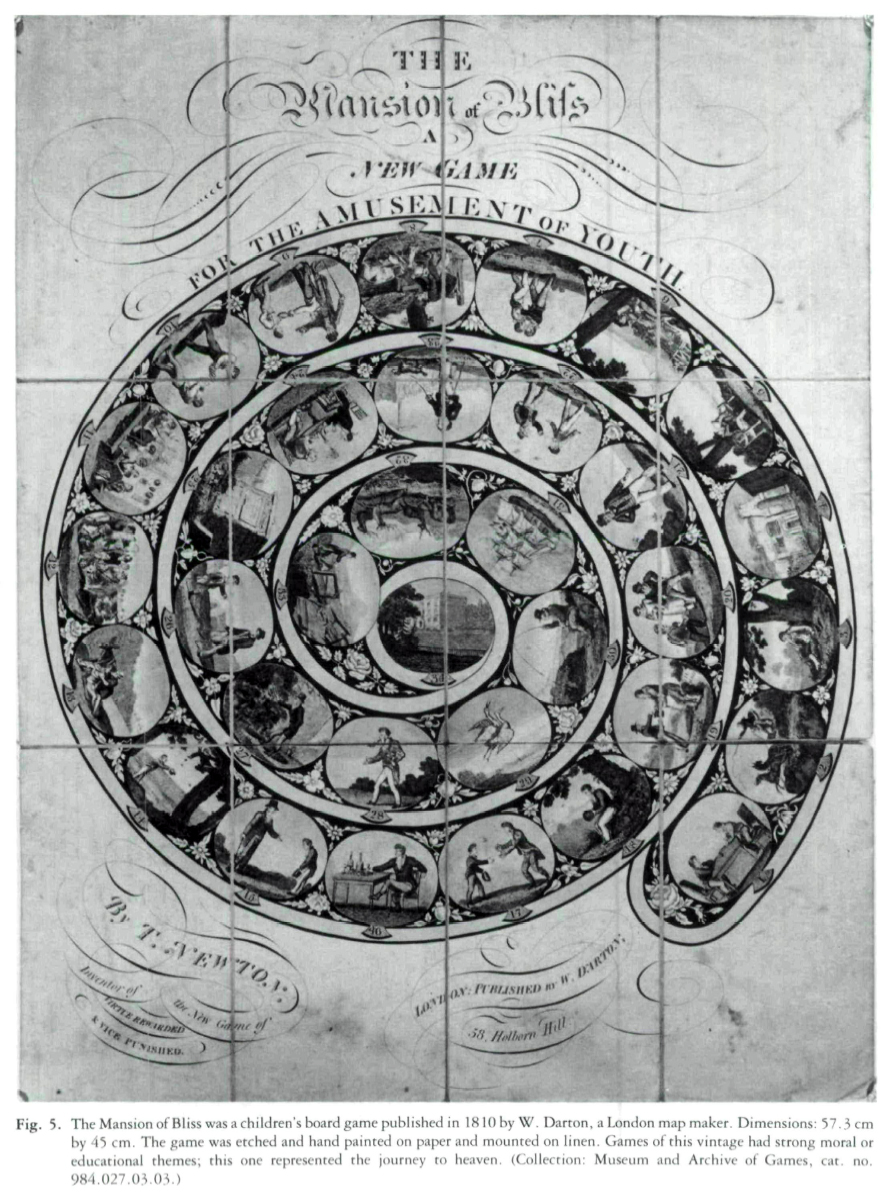 Display large image of Figure 4
Display large image of Figure 421 Manufactured boards in published form and specifically for children first appear in 1759 in Britain.20 The original producers of these games were map makers and book publishers, and these early games, etched, hand painted and mounted on linen, folded up just like maps and fitted into map folders. The game boards, like children's literature of the period, initially had predominately educational or moral themes. No doubt the instructional and moral nature of these items increased their attractiveness to the parents, since games such as the Mansion of Bliss (fig. 5) retailed for nine shillings each in 1810. Games were often played with a teetotum, a sort of top-tie considered more suitable for children than dice, which were often associated with gambling. Playing pieces for these games were wood, bone and ivory and these materials continued to be used until the end of the century when they were replaced with plastics.
22 These games were expensive, and to what extent they were available to those in Canada who could afford them is unknown, but a few are found in Canadian collections.
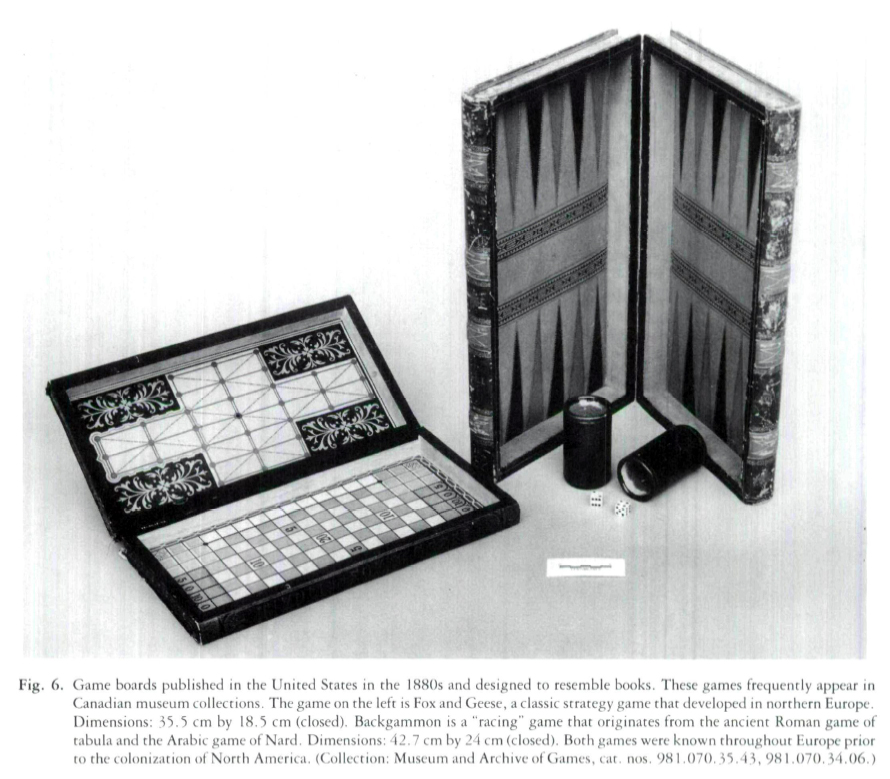 Display large image of Figure 5
Display large image of Figure 5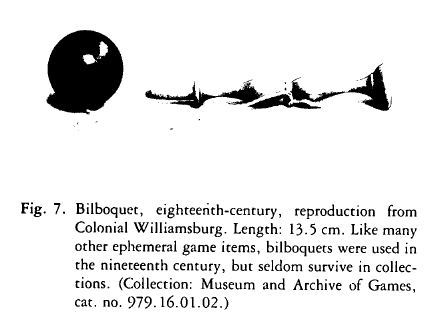 Display large image of Figure 6
Display large image of Figure 6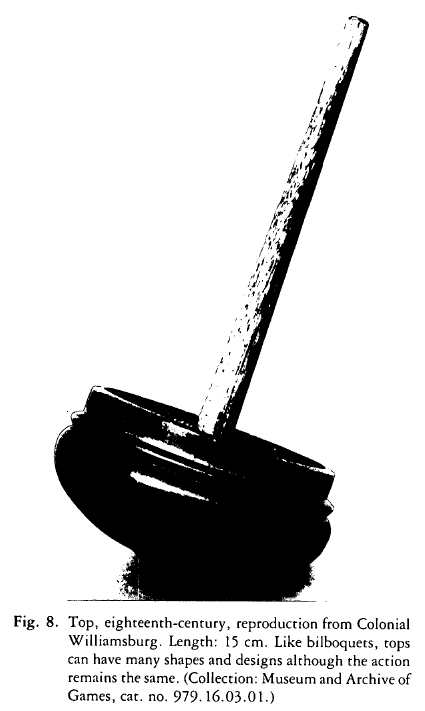 Display large image of Figure 7
Display large image of Figure 723 By the 1840s, games were lithographed on paper and mounted onto cardboard. Boxes were used for packaging, and this format has remained the same since. By the 1850s themes from popular culture and current events had largely replaced the earlier instructional and moral themes for board games. Examples include "The Comic Game of the Great Exhibition of 1851" (English, 1851) and Russia Versus Turkey, a game concerning the Crimean War (English, late 1850s). The Game of Robinson Crusoe (English 1850s) and The Game of Innocence Abroad (American, 1880s) were board games based on popular books of the period. Games based on other products of popular culture have continued to the present. By the turn of the twentieth century, these types of games reflected not only items of a political nature, such as the Suffragette Game, and current events, as in The Klondike Game, but also social attitudes toward ethnic groups, especially Blacks, Jews and Chinese, as in the game of Alabama Coon. Games continued to be designed based on books and later in the twentieth century on radio and television shows and movies. At the same time manufacturers incorporated traditional storylines into new games, such as Who Killed Cock Robin? They also produced commercial versions of traditional board games and from the mid- to the end of the nineteenth century these games were available in a manufactured format in leather or simulated leather, often designed to look like books. There is some thought that these games were disguised as books to hide their frivolous nature.21 This was probably not the case, and certainly the widespread advertising and availability of the games would have blown the "cover"! It was probably just a convenient and neat way to package game boards, allowing for a different game on each side and storage on a book shelf.
24 By the 1880s, many card games were available for children and like those today were often designed for playing games of matching sets.
25 In addition to the games mentioned, manufacturers offered games of physical dexterity, such as parlour (table) versions of tennis, croquet, and tiddly-winks. Fort and bagatelle were wooden board games that incorporated marbles as projectiles to hit targets. Fort stopped being manufactured and has never been revived, while bagatelle eventually evolved into pinball.
26 So then, what would one expect to find in a child's collection of games from the nineteenth century? It would depend very much on the time period and the child's ethnic traditions, social class, location (rural or urban) and to some degree religious affiliation. Handmade or locally made materials would likely be found in greater abundance in homes earlier in the century and would probably have persisted later in rural or poor urban homes, along with cheap manufactured materials.
27 There appears to be a dramatic change in children's game materials over the nineteenth century from the use of traditional simple and classic materials, often handmade or locally made, to widespread adoption of imported commercially manufactured games with new forms of play and themes based on popular culture. The presence of these materials confirms the development and recognition for the first time of a child leisure culture. By the last half of the nineteenth century the products for this culture were designed chiefly to entertain rather than act as media for moral or educational instruction. Children's exposure to these products through catalogues, store advertisements and displays probably led to their participation in deciding which games to buy.
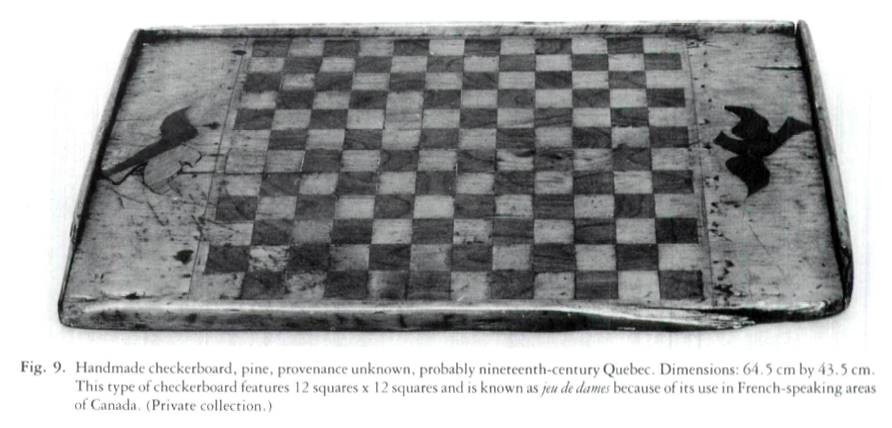 Display large image of Figure 8
Display large image of Figure 828 There are many questions about the incorporation of commercially manufactured games in nineteenth-century child's play that remain to be investigated. These games were available to a segment of the population that grew proportionately over the century with the growth of an educated middle class. How widespread were these games? What proportion of child's play did they occupy? How did they affect the creation and play of traditional games? Did time spent playing games with popular themes alter the child's world view? Finally, did the nature of play of these games affect traditional interactive patterns in child's game play?
29 Unfortunately, these questions will have to wait while researchers gather basic and fundamental information on just what manufactured games were played and to what degree traditional games remained represented in the child's leisure time.